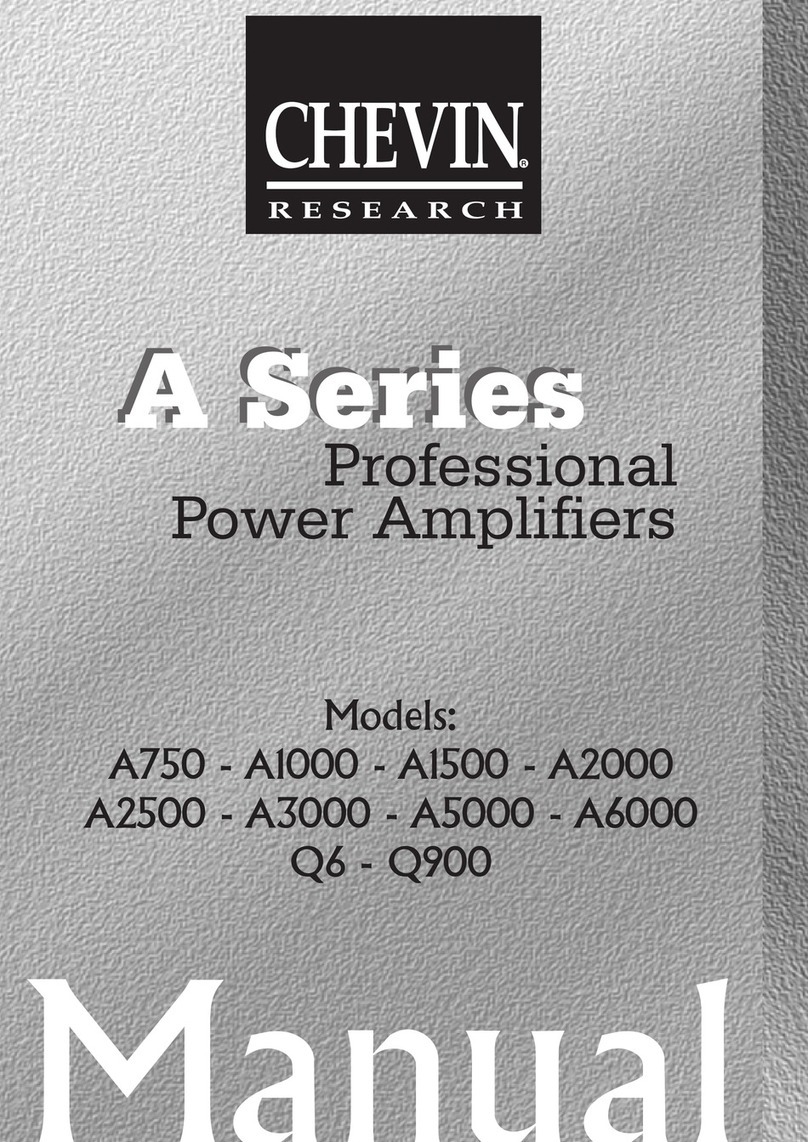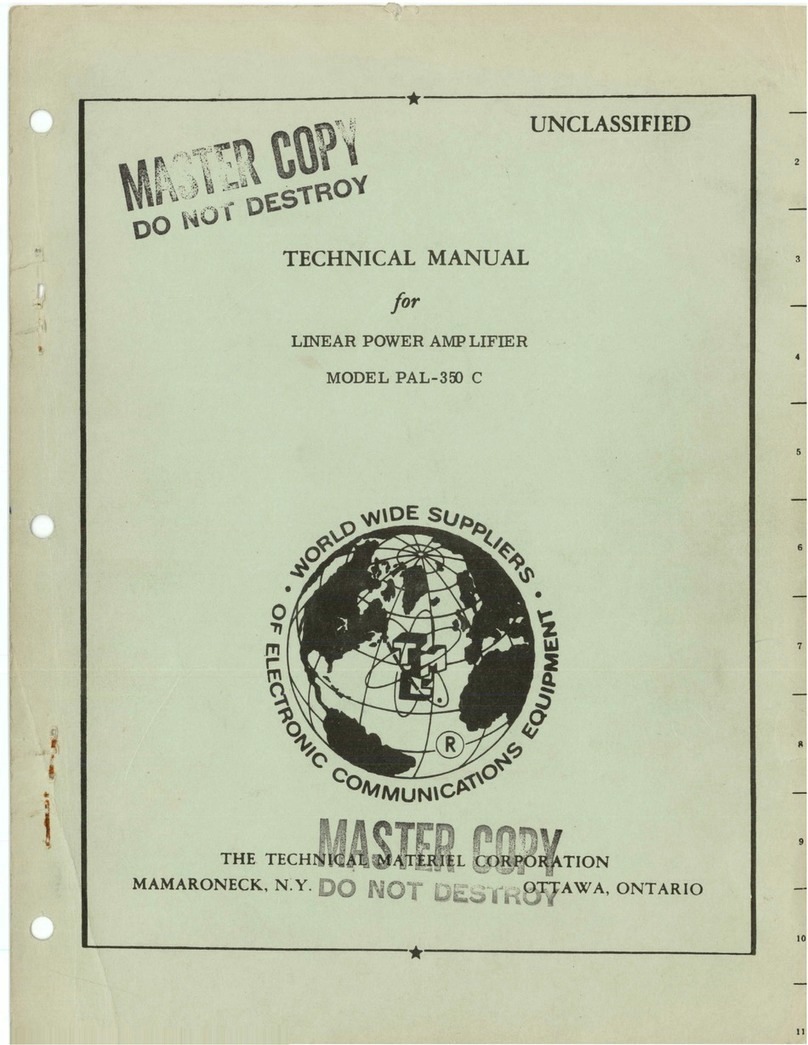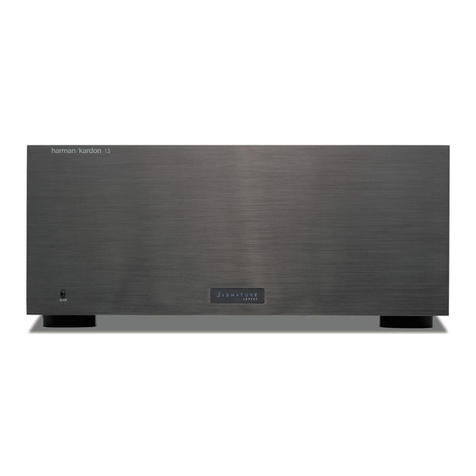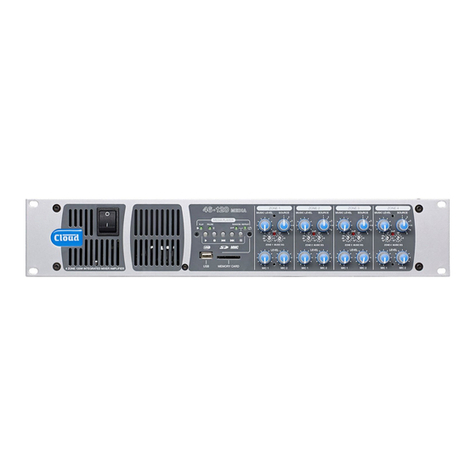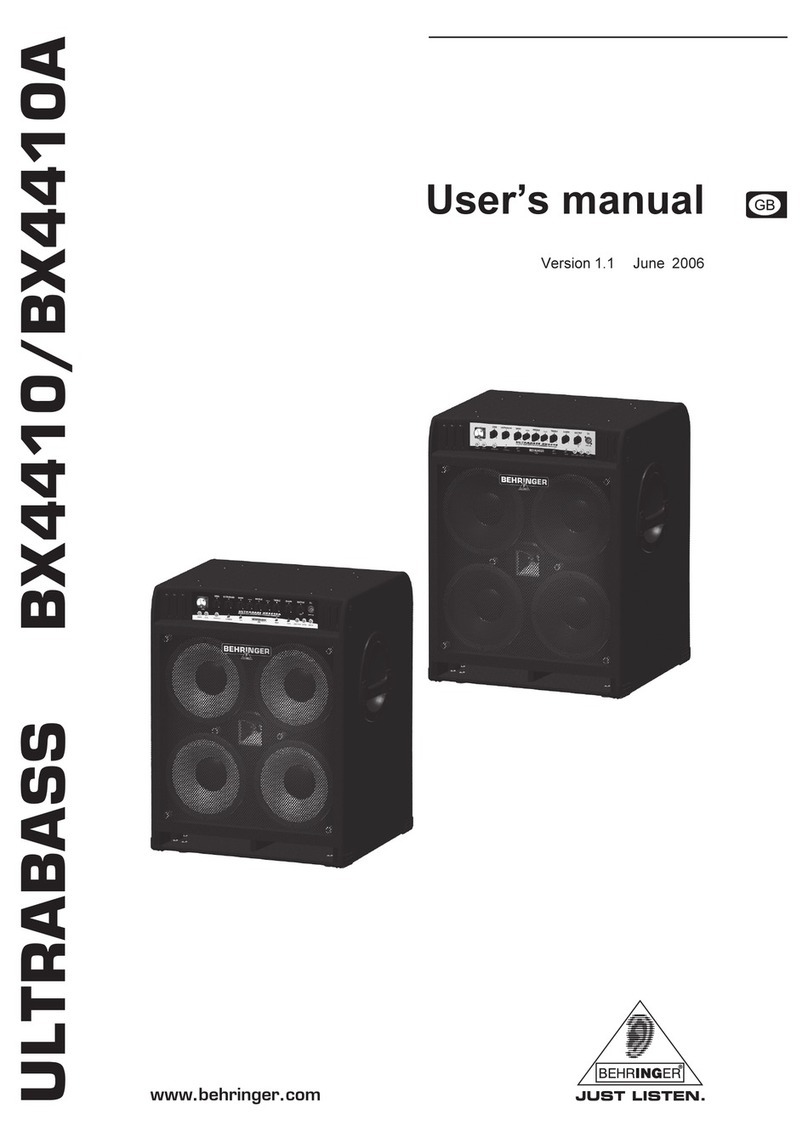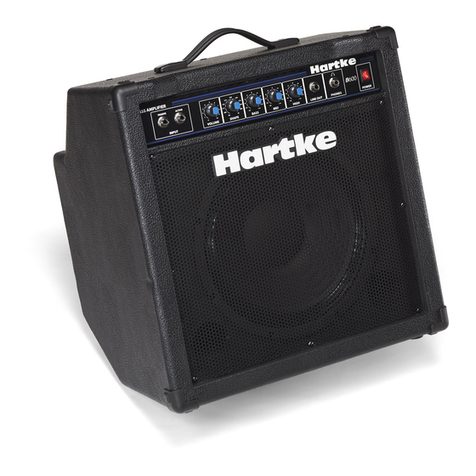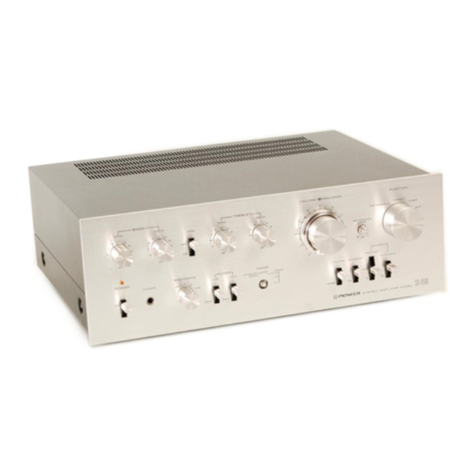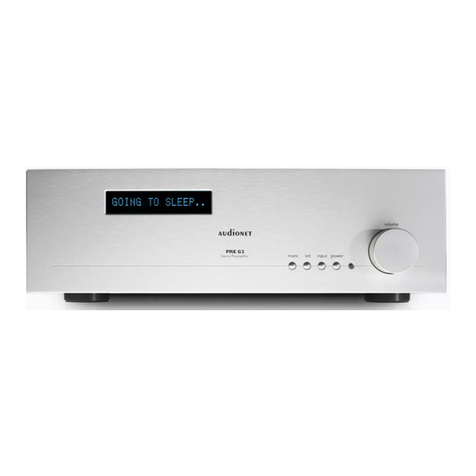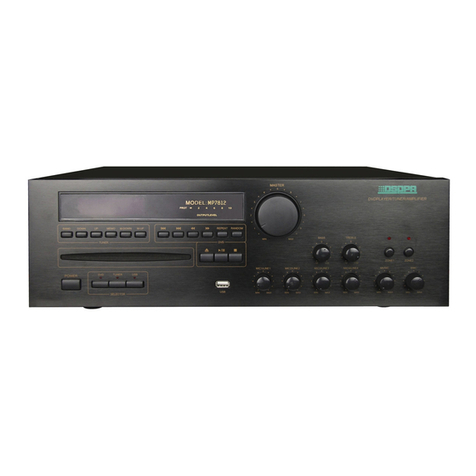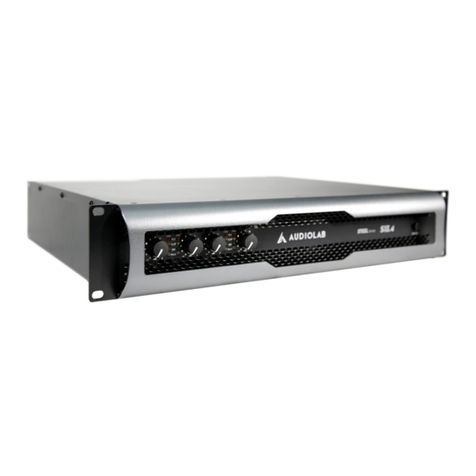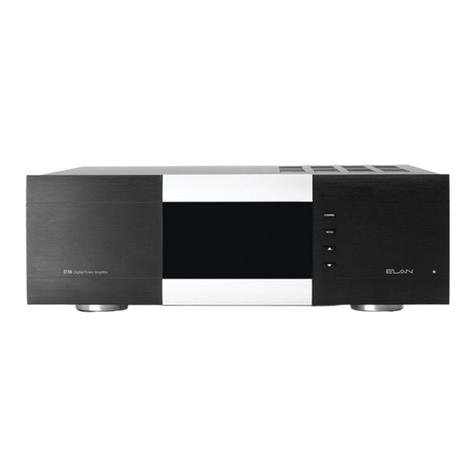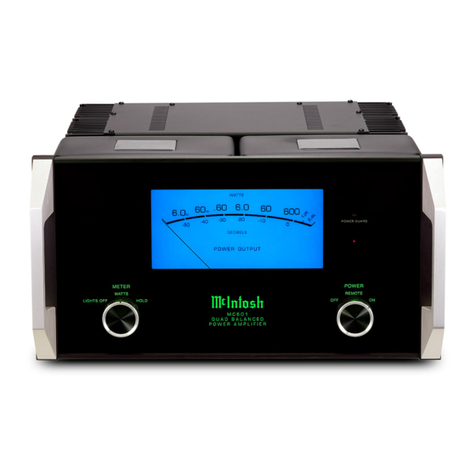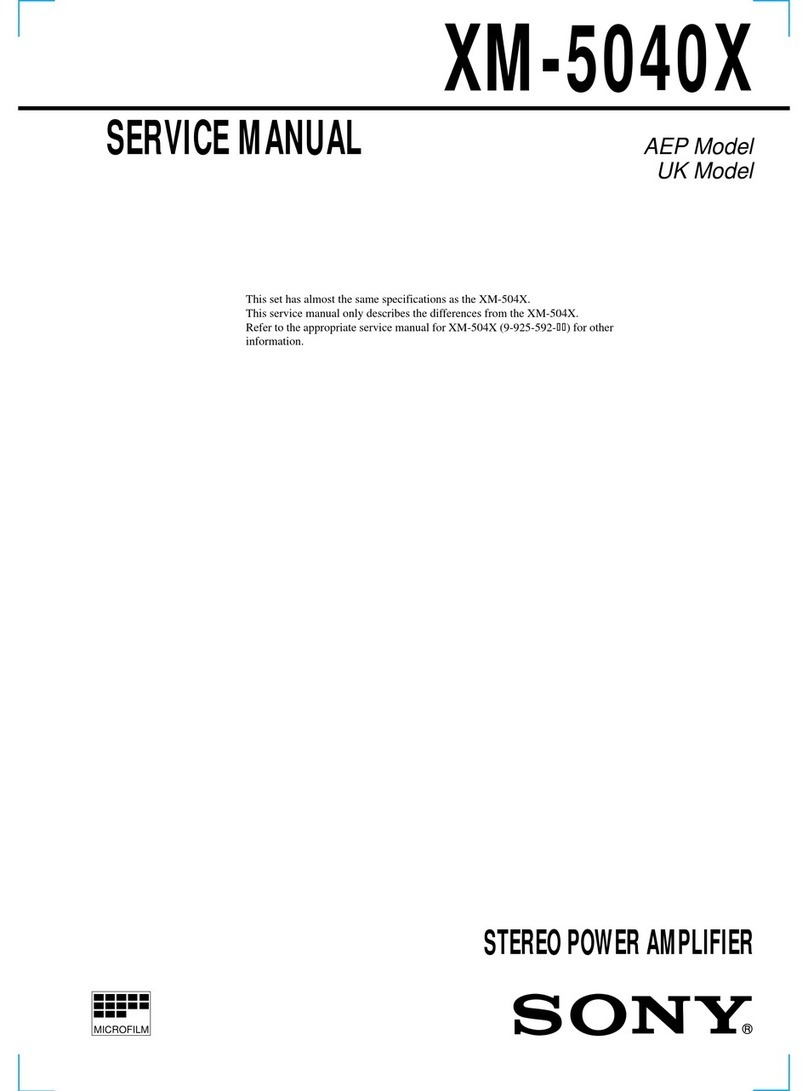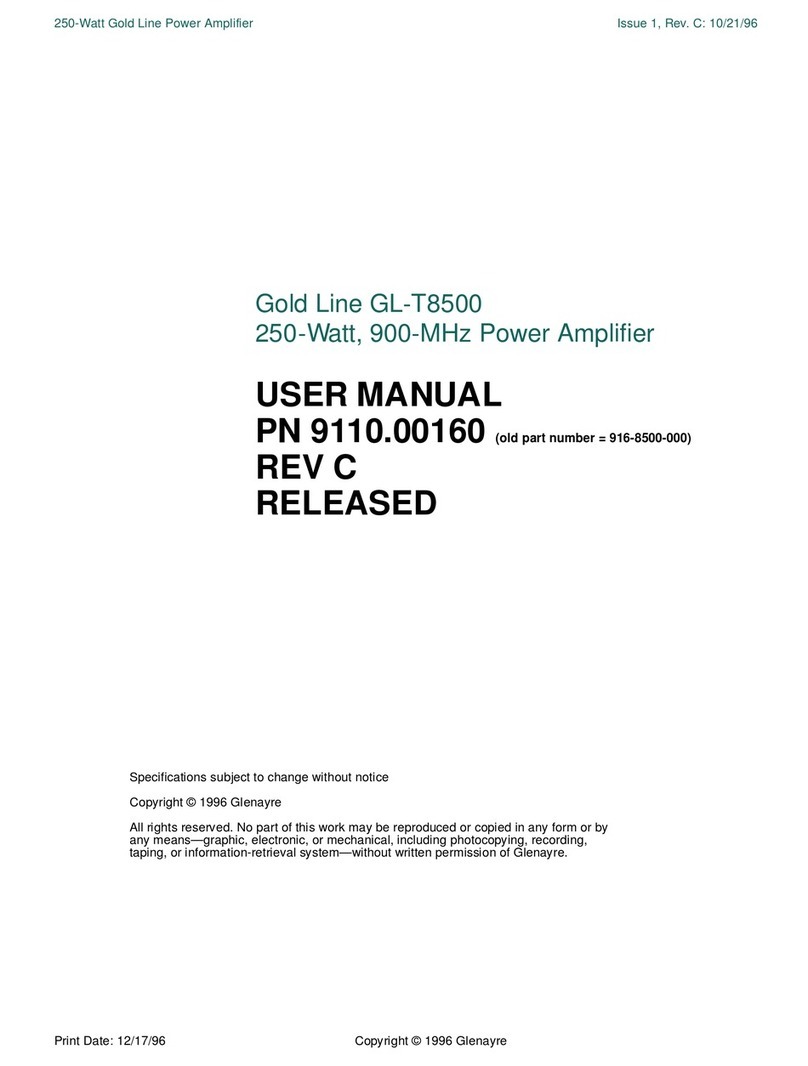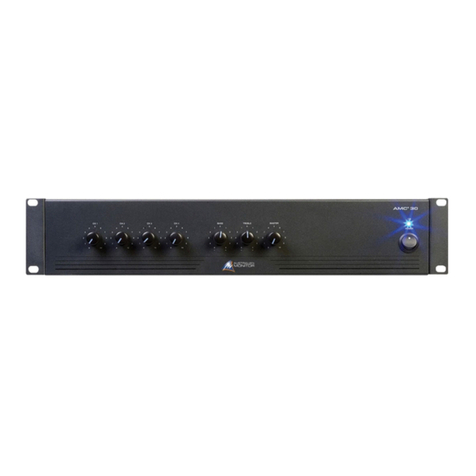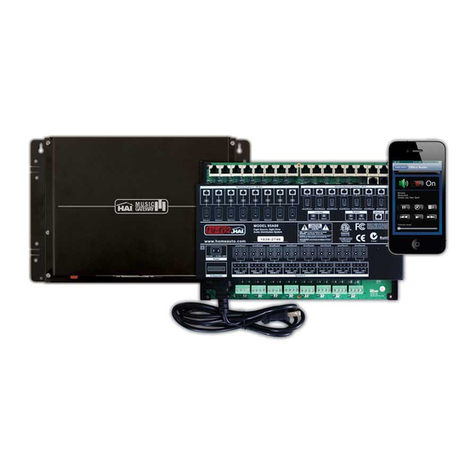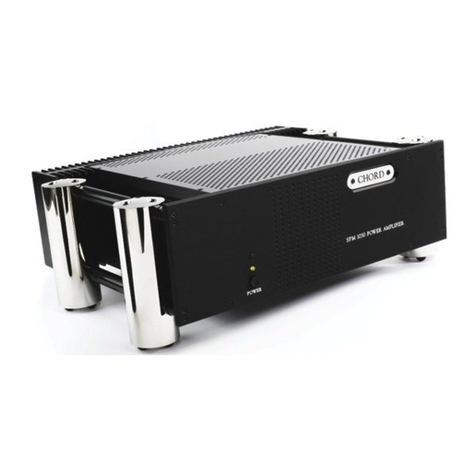Chevin S1500 User manual

USER MANUAL
S1500/S1504/S2000
PROFESSIONAL POWER AMPLIFIER
Chevin Research, Kreuzbichlstraße 29 A-6112 Wattens, Austria
Tel/Fax: +43 (0)5224 51398
www.chevin-research.com
Contents
Important Safety Instructions .................
Introduction ............................................
Front Panel ............................................
Rear Panel .............................................
Clip-Limiter ............................................
Subsonic Filter .......................................
2
3
3
4
4
5
GND Ground ..........................................
Stereo Mode ..........................................
Mono Mode ............................................
Bridge Mono Mode .................................
Installation and Dimensions .................
Technical Specifications ........................
5
5
6
7
8
11
Caution: To reduce the risk of electric shock do not remove the
cover. No user-servicable parts inside. Refer servicing to qualified service personnel.
Warning: To prevent fire or electric shock do not expose this equipment to rain or moisture.
The exclamation point within an equilateral triangle is intended to alert the user to
the presence of important operating and servicing instructions in the literature accompanying
the product.
The lightning flash with arrowhead symbol within an equilateral triangle is
intended to alert the user to the presence of uninsulted “dangerous voltage” within the
product’s enclosure that may be of sufficient magnitude to constitute a risk of electric shock.
WARNING - When using electric products basic precautions should always be followed,
including the following:
-Read all these instructions before using the product.
-Do not use the product near water e.g. near swimming pool, kitchen sink, bathtub, or
in a wet basement, etc.
-This product, either alone or in combination with other sound equipments, is capable
of producing sound levels that can cause permanent hearing loss. Do not operate
the product for a long time at high volume level.
-The product should be located away from heat sources such as direct sunlight or
other sources of heat.
-The product should be connected to a power supply only of the type marked on the
rear panel of the product.
-The power supply cord of the product should be unplugged from the mains socket
when left unused.
1 2

-Avoid allowing any objects to enter inside the product or spilling any liquid into it.
-The product should not be used when:
1. The power supply cord or plug has been damaged
2. Objects have fallen or liquid has been spilled into the product
3. The product has been exposed to rain
4. The product does not appear to operate normally or exhibits a marked change in
performance
5. The product enclosure has been damaged.
-Do not attempt to service the product. Refer servicing to qualified personnel.
The symbol of crossed-out wheeled bin is intended to inform the user that the
product is the subject to the requirements of the WEEE Directive of the European Parliament.
i.e. after the end of its lifetime the product should not be disposed as unsorted municipal waste
but should be collected separately.
Introduction
This 2-channel professional power amplifier provides high-value performance.
Features
- independent clip-limiters and subsonic filters (40Hz)
- operating modes: stereo / mono / bridge
- balanced XLR inputs
- Speakon outputs
- LED indicators for BRIDGE, PROTECT, SIGNAL, LIMIT IN, LIMIT OUT, SIGNAL,
POWER
Front Panel
1. Power switch
2. Gain controls for CHANNEL A, CHANNEL B
LED indicators for respective channels
Blue ON indicators indicates that the amplifier is on, no matter if there is any input
signal.
Green SIGNAL indicators indicates the presence of the signal.
Yellow LIMIT IN and LIMIT OUT indicators indicates that limiter is activated and
reduces input or output signal.
Red PROTECT indicators indicates that the amplifier is overheated. In this case it is
recommended to reduce the gain or to switch off the amplifier until its temperature is
lower.
Yellow light of BRIDGE indicates that the amplifier works in BRIDGE mode.
4. Air inlet
Rear Panel
1. INPUT connectors for CHANNEL A and CHANNEL B
2. SEND connectors providing the same signals as A and B input signals
3. OUTPUT connectors for CHANNEL A, CHANNEL B
4. OUTPUT BRIDGE – output connector for bridge mode
5. MAINS – AC power cable
6. MAINS FUSE or BREAKER
7. GND lift switches
8. Switches for subsonic filters of CHANNEL A and CHANNEL B
9. 3-position switch for MONO / STEREO / BRIDGE
10. Air outlet
Clip-Limiter
When audio signals drive the amplifier’s output circuit beyond its power capability it clips. The
clip limiter detects this and reduces the gain to minimise the amount of overdrive.
To preserve as much of the program dynamics as possible, the clip limiter works only if clipping
occurs frequently. Each channel has its own limiter that cannot be defeated.
3
4

Subsonic Filter
The subsonic (low-frequency) filter rolls off signals below 40Hz.
This means more power is available for the speakers’ rated frequency range.
The filter settings for each channel are controlled individually through the switches.
If the subsonic filter is off, there is 5Hz rolloff available to protect against DC or
sub-audio inputs.
When to use the subsonic filter
As a rule, speakers sound better with proper filtering. Unless you already have filtering in a
preceding device match the setting to the low frequency rating of your speakers.
Speakers with bass reflex are especially sensitive to frequencies below their rated limit.
The “OFF” position (= the subsonic filter is not used) should be used only for such applications
as studio playback monitoring, where you need to know the presence of unwanted sub-audio
signals in your mix.
GND Ground
The GND switches help you to avoid ground noise loops. Whenever the power
amplifier is installed in a 19" rack system being operated together with other
equipment, the recommended setting of the switch is ON. In case the power amplifier
is used together with equipments that are connected to different ground potentials,
the recommended setting is OFF.
Stereo Mode
Stereo mode is the “normal” way of using the amplifier. Each channel is fully independent,
seperate signals are connected at the inputs and seperate speakers are connected at the
outputs. Gain, filtering and limiting are fully independent and control their respective channel.
The amplifier works in stereo mode when 3-position switch is set on STEREO.
SEND: The same signal that is present at the INPUT connector is at the SEND connector to link
to other equipment.
Mono Mode
When the switch is set on MONO the amplifier operates with channels A and B having the same
signal. Each channel drives its own speaker and uses its own gain control, filter and clip-limiter
In mono mode you can use the other input connector to carry the signal to the other amplifiers.
This is often called “daisy chain“.
5 6

You can use mono mode to drive two speakers with one input signal while keeping independent
control of both channel-gains filtering and limiting.
Bridge Mode
When tho mode switch is set to bridge the amplifier operates in bridge. Bridge mode combines
the power of channel A and B. In this setting both channels operate as one. The result is twice
the output Voltage, four times the peak power and three times the sustained power of a single
channel.
Use bridge mono mode to deliver the power of both channels to a single load (4 -16 Ohm).
This setting uses the input, controls and settings of channel A, channel B is not used.
Precautions :
Bridge mode makes it possible to drive thousands of watts into a single speaker. AC current
consumption will be higher, too. Avoid excessive signal level and make sure that the wiring and
speaker can handle the power.
Excessive clipping may cause protective muting – speaker will not be driven for a few seconds.
Do not use 2-ohms loads ( nor 4-ohms in case of S1504 amplifier ).
Installation and Dimensions
ATTENTION !!
To avoid the risk of fire or electric shock :
Do not open the amplifier – all user-servicable parts are external - refer servicing to qualified
personnel !
If replacing the fuse use only the same type and rating!
Do not expose the amplifier to rain or moisture !
This manual contains important information for correct and safe use. Read it carefully before
using the amplifier. Keep it for future consultation.
Connection to the mains supply
Before connecting the amplifier to the mains socket always make sure that:
-The electric system and mains socket have an adequate grounding – compatible with
the safety norm (If you are uncertain consult specialized personnel);
-The mains voltage corresponds to that shown on the rear panel ( accepted allowance is
up to +/-10%);
-Power cord is not damaged
-The on/off switch is in the off position.
Switching on and off
In your sound reinforcement system always switch on the amplifier after all the other equipments
and always switch it off before them, if possible with gain controls set at minimum – this will
avoid dangerous signal peaks.
7 8

The amplifier can be used in 19‘’ rack mounting or single.
Use 4 screws and washers when mounting the amplifier to the front rack rails.
Support the amplifier at the rear also, especially in mobile use.
Audio connections
Always use good quality cables of the appropriate type.
Take care of cables and check their condition frequently. Grip them by the connector, do not pull
them.
Bad quality cables is frequent cause of operation problems.
Note: If you use a balanced signal then use only balanced cables. Even one unbalanced cable
will unbalance the entire signal chain, possibly causing hum.
Safe operating levels
The protective muting system guards against excessive internal temperatures.
With normal cooling and 2-16 ohm loads the amplifier will handle the full power ! Lower load
impedances and higher signal levels produce more internal heating. With 4-ohm loads, frequent
and prolonged clipping may trigger protective muting.
Bridge mode doubles the output impedance; so 4-ohm is the minimum load mpedance.
Interference – preventing and identifying
First of all check that the amplifier is installed in a place free from industrial or RF (radio
frequency) interference. Avoid installing it very near TV sets, mobile phones, etc. as these can
cause interference.
When connecting the other components of your sound system watch out for so-called “ground
loops” which could cause hum and jeopardize excellent sound quality.
To identify the cause of any interference in your sound system, connect the various sections of
the mixer to other equipments in the following order and listen to resultant sound :
Outputs : amplifiers + loudspeaker boxes (Master outputs)
amplifiers + monitors (AUX outputs)
effects (AUX outputs or EFF send/return)
Inputs : instruments with line signals (keyboards, samplers, recorders, ...)
microphones (lastly and one by one).
Protection and maintenance
After long period of use, particularly in dusty surroundings, accumulated dust may obstruct
cooling. Without opening the amplifier dust can be removed with a jet of compressed air, forcing
it through the vents. But first make sure that the amplifier is disconnected from the mains supply.
If dust is excessive do not open the amplifier but contact the nearest qualified centre.
Any dust on the outside of the enclosure can be removed using a dry soft cloth or brush. Never
use alcohol, acetone or solvents of any kind.
The amplifier requires no further maintenance.
9 10

Technical Specifications
Output Power
1% THD, both channels driven
8 Ohm per channel
4 Ohm per channel
2,7 Ohm per channel
2 Ohm per channel
1% THD, one channel driven
8 Ohm per channel
4 Ohm per channel
2,7 Ohm per channel
2 Ohm per channel
Bridge mono
8 Ohm, 1% THD
4 Ohm, 1% THD
S1500
600W
1100W
-
1600W
625W
1150
-
1750W
2200W
3400W
S1504
800W
1320W
1500W
-
840W
1444W
1720W
-
2600W
-
S2000
700W
1173
-
1764W
730W
1260W
-
1922W
2300W
3500W
Distortion / 1kHz/THD % < 0,02%
Frequency response
at 10 dB below nominal power 20 Hz – 20 kHz +0/-1dB
20 Hz – 50 kHz +0/-1dB
Subsonic filter on / off
40 Hz / 80 Hz
Damping factor / 8 Ω / 1kHz > 200
Slew rate / 8 Ω20 V / μs
Signal – noise ratio
20 Hz – 20 kHz below rated power
“A” weighted
- 103 dB
- 112 dB
Input sensitivity
full rated power / 8 Ω
1V
Input impedance 10 k Ωunbalanced
20 k Ω balanced
Controls front panel: mains switch
gain controls (both channels)
rear panel: switches for mode selection
subsonic filter
GND lift on or off
LED Indicators yellow BRIDGE, red PROTECT,
yellow LIMIT IN and LIMIT OUT
green SIGNAL, blue ON
Connectors Input: balanced XLR
Output: Neutrik Speakon
Cooling step-switched fan
Air flow: front to back
Protection short circuit, thermal, load-mismatch, DC
Output circuit type Class H
Dimensions (mm) W x H x D = 483 x 88 x 387 (2U)
Weight 12 kg
Power AC 220 – 240V ~ 50 – 60 Hz
Max power consumption (230V ~) 3680VA
This manual is intended for informational purposes only. All details included herein are subject to change without notice.
Chevin Research shall not be held responible for any damages, direct or indirect, arising from or relating to the use of this
manual.
© Chevin Research 2008. All rights reserved.
11
12
This manual suits for next models
2
Table of contents
Other Chevin Amplifier manuals


